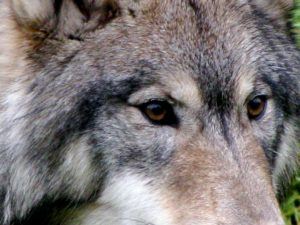
Gray wolf. Photo: Jeffrey St. Clair.
Let’s start with some facts:
1) The majority of New Mexicans want to see Mexican wolves recovered.
2) Public lands livestock are a leading source of conflict for the wolf recovery program.
3) Livestock on public lands displace native wildlife through competition for food and driving them out of preferred habitats.
4) Public lands livestock permittees are getting a screaming deal: $1.35 per month per cow/calf pair for an all-you-can-eat buffet.
5) There are multiple programs in multiple agencies that compensate ranchers for livestock lost to wolves. (e.g. here and here)
These facts provide some important context for a situation happening right now near Reserve, N.M. on the Gila National Forest. One rancher – who shall remain nameless – is experiencing significant levels of wolf predation grazing their livestock on public lands. This rancher is requesting that the U.S. Fish and Wildlife Service remove the culpable wolf or wolves and raising a stink online about their losses, generating a whole lot of sympathy for their heavily-subsidized livestock operation, and gaining some support from regional elected officials.
But here’s the thing. For reasons that aren’t quite clear, this particular rancher repeatedly places bred cattle onto the same public lands pastures, year after year, in full knowledge that calves dropping in December, January, and February are disproportionately likely to die of natural causes, and are irresistible to wolves. The ranch has been losing cows and calves every winter, yet nothing has changed with the livestock management regime to avoid this conflict. The ranch, in turn, demands that wolves be removed each year.
Thus far, between 2018 and 2020, seven endangered wolves have been “removed” (lethally or to captivity) by the Fish and Wildlife Service to accommodate this one ranch, including two who were caught in private traps and died in captivity from their injuries and stress. At least six additional wolves have also been caught in private traps on the allotment and released. An entire pack of wolves has been removed from the area, and yet the problems persist.
Now, the ranch is pushing for wolf removal number eight. It’s a black hole for wolves.
It’s also a black hole for taxpayer dollars. This particular ranch has received tens of thousands of dollars in federal money over the last few years to compensate for the livestock losses, paid from a variety of programs that require varying levels of proof of wolves’ involvement in the cattle deaths, not to mention the ridiculously low federal grazing fee that underpins the whole operation.
Which raises the questions: If this rancher really wanted to prevent livestock deaths, why do they repeatedly use the same high-elevation winter pastures for calving in the dead of winter, leaving vulnerable calves and birthing mother cows at risk? If the Gila National Forest is truly a partner in Mexican wolf recovery, why does the agency allow problematic management year after year? And why, if we’re paying for the dead livestock anyway, do we – the American public – also have to pay with the priceless lives of rare Mexican wolves by removing them from wild lands through death or captivity?
Wolves are apex predators who depend on public lands’ habitat. It’s the ranchers who need to change their management to reflect responsible stewardship of wildlife habitat on public lands grazing allotments, and it’s the Forest Service who needs to ensure that this occurs. The public wants wolves to be restored to their natural range in New Mexico, and the Forest Service must require that multiple uses of the forest don’t impede the recovery mandate of the Endangered Species Act.
Which leaves us with this final fact: One definition of insanity is doing the same thing over and over and expecting different results.
Stop the insanity. Leave the wolves wild and demand more of the humans.